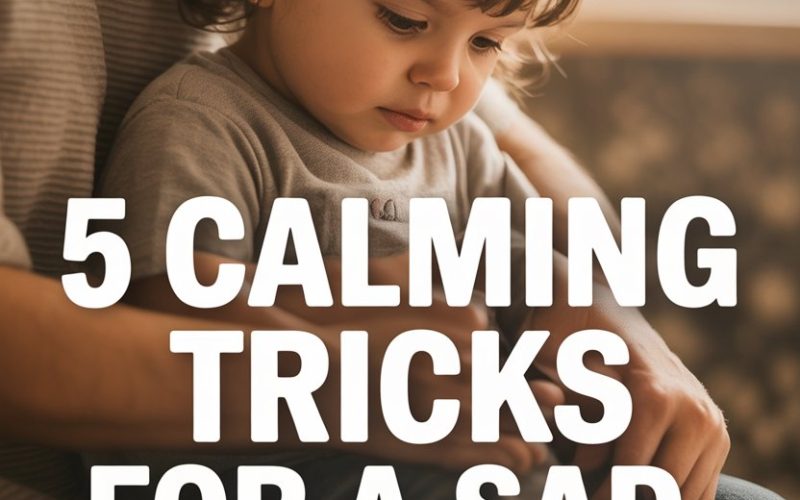Parenting comes with a lot of surprises. Some involve chewed crayons, and others involve a child so silent and withdrawn you wonder if you’ve gone temporarily deaf.
When your child shuts down, it can leave even the most experienced grown-ups feeling helpless.
But—good news—there are ways to gently coax them back to calm.
1. The Power of Presence
You’re probably itching to fix things with a helpful list of solutions, or maybe you’re tempted to pepper your child with questions like a very well-meaning detective.
Yet, sometimes, the most powerful thing you can do is simply be there. Seriously—just plant yourself next to your child and let them know you’re available.
A study from the University of California, Riverside actually shows that kids often feel safer when parents are physically close during tough emotional moments.
Your presence is a steady anchor in a world that suddenly feels stormy for them. This can mean sitting quietly together on the sofa, reading your book while they cuddle a stuffed animal, or even folding laundry near them.
Silence isn’t awkward when it’s loving. You’re showing your child they don’t have to perform or “bounce back” right now. You’re simply there—no words required.
2. Name It to Tame It
Here’s a secret: naming feelings isn’t just for therapy sessions or Pixar movies.
When a child is sad and shuts down, they’re often overwhelmed by a tidal wave of emotions they can’t quite identify. Giving those feelings a name can shrink them down to size.
Daniel Siegel, renowned child psychiatrist, swears by this “name it to tame it” approach.
Gently offer words to help your child make sense of their emotions. Try, “It looks like you’re feeling really sad and quiet today. That’s okay. Do you want to talk about it, or just sit together?”
If your child isn’t ready to chat, that’s fine (and perfectly normal). You’ve done the heavy lifting by showing them that tricky feelings have names, and that those feelings don’t scare you off.
3. Small Sensory Shifts
Sadness sometimes traps children in their own heads, making it hard to re-engage with the world. That’s where sensory tricks come in—and no, you don’t need a Pinterest-level setup or a mystical singing bowl collection.
Try suggesting an easy, low-pressure activity that involves touch, smell, or movement. Maybe your child likes to squish playdough, wrap up in a fluffy blanket, or help you stir cake batter.
For younger kids, even watching a favorite bubble-blowing video or running hands under warm water can help.
Research from the Child Mind Institute shows that these gentle sensory experiences can interrupt a shutdown spiral and bring kids back to the here-and-now.
If your child needs a little more motivation, you can always frame these activities as “helping you”—kids often feel better when they get to be useful.
4. The Art of the Gentle Invitation
Nothing triggers resistance quite like pressure. If your child is a human clam, prising them open with crowbar questions (“What’s wrong? Why won’t you talk to me?”) is doomed to fail.
Instead, try a gentle invitation. “I’m making some snacks—would you like to join me?” or “Want to come water the plants together?”
The trick is to offer connection without requiring conversation. Activities that use hands but don’t demand eye contact—like colouring, sorting socks, or playing with toy cars—often work wonders.
A clinical review from the University of Cambridge found that kids tend to open up more during side-by-side activities, rather than face-to-face grilling.
Sometimes you start out discussing the weather and end up hearing about why school was awful today.
Don’t worry if your invitation is declined at first. It’s not a sign of failure, just a sign that your child needs a little more time in their shell before poking out to see what’s up.
5. The Magic of Routine and Ritual
When sadness lingers, the world feels unpredictable. Routines can act like a safety net, reassuring your child that some things are steady, even if feelings are messy.
This doesn’t mean you need a minute-by-minute schedule (unless you fancy turning your living room into a military boot camp).
Instead, focus on small, predictable rituals: the nightly bath and story, the Sunday pancake breakfast, the evening family walk (or, let’s be honest, the evening family negotiation about bedtime).
Harvard’s Center on the Developing Child highlights how routines build resilience, giving children a sense of security when emotions are big and wild.
Even something as simple as lighting a candle at dinner or singing a sleepy song before bed can become a comforting anchor.
Sadness may barge in uninvited, but rituals remind your child that it won’t outstay its welcome.
When Nothing Seems to Help
Sometimes, despite your best efforts—and your best snacks—your child stays sad and withdrawn. Every parent has been there.
If your child’s sadness lingers for weeks, starts affecting their sleep or eating, or they seem to lose interest in everything they once loved, reaching out to a GP, school counsellor, or child psychologist is a wise move.
You’re not admitting defeat; you’re showing your child that seeking support is a sign of strength, not weakness. Kids are clever: they notice when grown-ups ask for help too.
The Soft Reboot
Children bounce back at their own pace, sometimes with a cheerful leap, sometimes with the speed of a tortoise on a Sunday stroll.
The right combination of presence, gentle words, sensory comfort, low-pressure invitations, and predictability can make a world of difference—even if it feels like nothing is happening in the moment.
Parents worry. It’s in the contract.
But your calm steadiness, even when you’re secretly googling “child sad won’t talk what do I do,” plants seeds of security your child will never forget.
And with enough time—and perhaps a biscuit or two—your little one will find their way out of the shell and back into the world.
Breathe. You’re doing better than you think.





